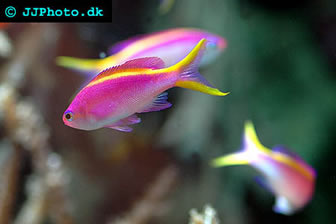Anthias
Anthias are found in the subfamily Anthiinae in the family Serranidae of the order Perciformes. They are sometimes referred to as Fancy Sea Basses. The first described Anthiinae was Anthias anthias, a species native to the Mediterranean Sea and north-eastern Atlantic. It was given its name in 1758 by Carolus Lennaeus.
Anthias in the aquarium
Anthias are peaceful, lively and colourful and it comes as no surprise that many aquarists wish to keep them. Many species are fairly small and will not need a huge aquarium. A majority of the commonly kept species belong to the genus Pseudanthias.
Compared to the other members of the family Serranidae, Anthias are rather delicate creatures but they can be kept by devoted aquarists willing to cater for their needs.
Geographical range, habitat and habits
If you have scuba dived along a tropical marine reef or watched a reef documentary, you have most likely seen these brilliant little fishes since they are found in large swarms around coral reefs in all the tropical oceans of the world, including the Mediterranean.
Anthias form huge swarms that can comprise several thousand individuals. They are schooling fish that will form smaller subdivisions within the large swarm. These subdivisions are commonly referred to as harems. Anthias develop intricate social structures based on the number of male and females in the group as well as on their position on the reef. Each harem will contain one (colourful) male fish and 2 to 12 females. The male is dominant and the females will establish a strict hierarchy among themselves. A harem will also often contain one or two non-dominant males as well. These males are not as brightly coloured as the dominant male and they are not territorial. The dominant male is highly territorial and will vigorously defend his harem members and the reef area claimed by the harem. He will also perform acrobatic displays where he makes fast u-turns among the females.
Anthias are protogynous hermaphrodites. All the offspring is born female, but males will develop eventually. If the dominant male is removed from a harem, a sub-dominant male will try to take his place, but the removal of the dominant male can simultaneously cause the largest female to turn into a male and compete with the sub-dominant male for supremacy. If the fish is kept in a restricted area with no place to hide, such as a small aquarium, serious injury can occur.
Feeding
Anthias feed chiefly on zooplankton. Zooplankton is one of many types of plankton that drifts around in the ocean. Unlike phytoplankton, zooplankton can not carry out photosynthesis and must therefore feed on phytoplankton, detritus and similar.
Anthias Articles
Threadfin Anthias – Care for this popular anthias, Nemanthias carberryi
Bartlett's Anthias – Information on how to keep Pseudanthias bartlettorum
Bicolor Anthias – A guide to Pseudanthias bicolor
Lyertail Anthias – How to keep and care for Pseudanthias squamipinnis
Anthias
Aquarium Chillers
Basses
Batfish
Blennies
Butterflyfish
Cardinalfish
Clown fish
Corals
Damselfish
Files
Goatfish
Gobies
Gorgonians
Grammas
Groupers
Grunts
Hawkfish
Jawfish
Jellyfish
Lionfish
Dragonets
Mantis shrimp
Marine angelfish
Marine Catfish
Moray eels
Nudibranch
Octopus
Pipefish
Protein skimmers
Pufferfish
Rabbitfish
Rays
Snappers
Scorpionfish
Sea Anemones
Sea horses
Sea Stars
Shark Fish
Shrimps
Snails
Squirellfish
Surgeonfish
Triggerfish
Wrasses

